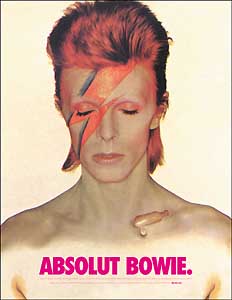
beautyme collections culture cuisine motor music search
|
ABSOLUT ALBUM COVERS The Artists, The Art and The Albums A record sleeve starts as a blank canvas. Musicians create a mood with words and melodies and sound, and artists transform it into a picture. The image may give insight into the music encased inside or it may simply encourage the viewer to interpret the words and images in his or her own way. ABSOLUT ALBUM COVERS, a salute to the artists whose designs have left an indelible mark on music, pays homage to the visual masterpieces that have helped define a musical revolution.
|

ABSOLUT
ALBUM COVERS. ABSOLUT BOWIE. Duffy was one of the terrible three of British photography in the sixties; Along with David Bailey and Terry Donovan, he was responsible for injecting a shot of street-wise working-class energy into the world of fashion photography. He continued to utilize the method in the cover photograph for Aladdin Sane; it showcased Bowie's "glam-rock" character through campy make-up and glitter, in the guise of a lightning bolt streaked across his face. The sleeve was also revolutionary in that it was printed in seven colors, a process not possible in the UK at the time; it had to be printed in Switzerland instead. In Jerry Hopkins' biography, Bowie, David Bowie explains, "Aladdin Sane was Ziggy (the character) meeting fame… a subjective Ziggy talking about America, my interpretation of what America means to me…Wanting to be up on stage performing my songs, but on the other hand not really wanting to be on those busses with all those strange people…so Aladdin Sane was split down the middle..." Rolling
Stone reviewed the record in 1973; in it Ben Gerson wrote, "A
lightning bolt streaks across David's face; on the inside cover
the lad is airbrushed into androgyny, a no less imposing figure
for it…Though he has been anointed to go out among us and
spread the Aladdin Sane was the first album Bowie released after The Rise And Fall of Ziggy Stardust And The Spiders From Mars. It was one of the most highly anticipated releases since The Beatles' self titled album and became Bowie's first #1 record. |